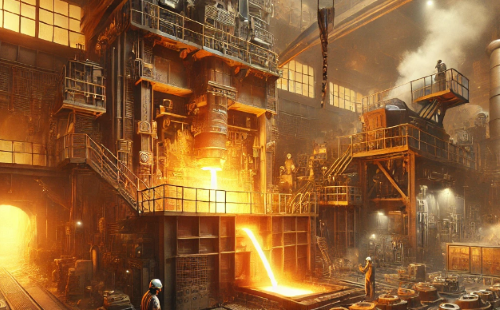The Contact Material Range of Refractory Metals
Introduction
Refractory metals are renowned for their high melting points, strength at elevated temperatures, and exceptional resistance to wear and corrosion. These properties make them indispensable in a wide range of industrial applications, from aerospace engineering to chemical processing equipment.
The selection of compatible contact materials is crucial to maximize the performance and longevity of refractory metals in various environments. This article discusses the compatible and reactive materials for each of these refractory metals, providing insights crucial for engineers and designers.

Understanding Refractory Metals
Refractory metals are a class of metals that are extraordinarily resistant to heat and wear. The term is primarily used to describe five elements: tungsten (W), molybdenum (Mo), tantalum (Ta), niobium (Nb), and rhenium (Re). These metals share several key characteristics, notably their exceptionally high melting points, which are markedly higher than those of most other metals.
Refractory metals are distinguished by several significant properties that make them ideal for use in a variety of challenging applications:
1. High Melting Points: Tungsten, for example, melts at 3422°C, making it the metal with the highest known melting point. This trait allows refractory metals to perform exceptionally in high-temperature environments like furnace components and rocket engines.
2. High Density: Metals like tungsten have densities as high as 19.25 g/cm³, providing substantial mechanical strength and making them suitable for applications requiring heavy materials in compact forms, such as radiation shielding and counterweights.
3. High Hardness and Strength: These metals are not only hard but also strong, particularly at high temperatures, making them resistant to deformation under mechanical stress.
4. Corrosion Resistance: Metals like tantalum and niobium are highly resistant to corrosion, including from acids, which is crucial in chemical processing industries.
Related reading: All You Need To Know About Refractory Metals
Contact Material Range of Refractory Metals
Therefore, refractory metals are invaluable in applications demanding extreme conditions that other materials cannot withstand. Nevertheless, their utilization also presents certain limitations that can impact their application. Challenges, especially contact material range, need to be managed carefully.
Contact material range refers to the selection of materials that can safely and effectively be used in direct contact with refractory metals. These materials are chosen based on their ability to withstand similar extreme conditions without corroding, degrading, or otherwise negatively interacting with the refractory metals. To optimize design and ensure durability, materials are categorized into compatible and reactive groups. Compatible materials are those that maintain structural integrity and performance when used with refractory metals, such as certain ceramics and metals that do not react at high temperatures. Conversely, reactive materials are those that may cause degradation, such as corrosion or chemical reactions, which could lead to component failure. Understanding these categories helps in making informed decisions that enhance the reliability and lifespan of applications involving refractory metals. The following are some typical refractory metals and their Compatible and Reactive Materials.
1. Tungsten (W)
Tungsten is highly valued for its robustness and high temperature resistance, making it a preferred material in demanding environments such as aerospace and electronics.
- Compatible Materials: Tungsten forms effective pairings with steel, nickel, ceramics, and glass, benefiting applications that require high thermal and electrical conductivity.
- Reactive Materials: It is less suitable for use with materials that promote oxidation or enhance brittleness, such as certain copper alloys at elevated temperatures, which can compromise its structural integrity.
2. Molybdenum (Mo)
Known for its versatility, molybdenum serves as a core material in high-temperature furnaces and electronic applications.
- Compatible Materials: Molybdenum is typically paired with ceramics and glass, utilizing its excellent thermal shock resistance and high melting point.
- Reactive Materials: It is advisable to avoid using molybdenum with oxidizing agents above 400°C, as rapid oxidation can occur, diminishing its effectiveness and durability.
3. Tantalum (Ta)
Tantalum's outstanding corrosion resistance makes it a staple in the chemical processing industry and medical device fabrication.
- Compatible Materials: This metal is compatible with a broad range of chemical substances, including acids and bases, and pairs well with noble metals.
- Reactive Materials: However, tantalum is vulnerable to alkaline solutions and molten metals, and can suffer from hydrogen embrittlement at high temperatures.
4. Niobium (Nb)
Niobium is frequently used in superalloys and applications demanding excellent corrosion resistance.
- Compatible Materials: It works effectively with ceramics and is commonly used in environments that require resistance to harsh chemicals.
- Reactive Materials: Niobium's performance can be compromised by exposure to oxygen and halogens at high temperatures, necessitating controlled environments.
5. Rhenium (Re)
Rhenium enhances the properties of other refractory metals when alloyed, particularly in high-temperature applications.
- Compatible Materials: It is often alloyed with tungsten and molybdenum, and its compatibility with platinum and other platinum-group metals is exploited in applications requiring durable electrical contacts.
- Reactive Materials: Although relatively inert, rhenium must be carefully used in oxidizing atmospheres at elevated temperatures.
Conclusion
Selecting the appropriate contact materials for refractory metals (See Table 1.) is essential to ensure the stability and functionality of these metals in their respective applications. Engineers must consider thermal compatibility, chemical reactivity, and mechanical properties when integrating refractory metals into their designs. Understanding these interactions helps in achieving optimal performance and extending the lifespan of the materials in complex industrial applications. For more details, please check Stanford Advanced Materials (SAM).
Table 1. Contact Material Range of Refractory Metals
Metal | Compatible Materials | Reactive Materials | Applications |
Steel, nickel, ceramics, glass | Copper alloys (at high temperatures) | Aerospace, electronics | |
Ceramics, glass | Oxidizing agents (above 400°C) | High-temperature furnaces, electronics | |
Acids, bases, noble metals | Alkaline solutions, molten metals, high-temperature hydrogen embrittlement | Chemical processing, medical devices | |
Niobium (Nb) | Ceramics, environments requiring chemical resistance | Oxygen, halogens (at high temperatures) | Superalloys, chemical resistance |
Rhenium (Re) | Tungsten, molybdenum, platinum-group metals | Oxidizing atmospheres (at elevated temperatures) | High-temperature alloys, electrical contacts |


